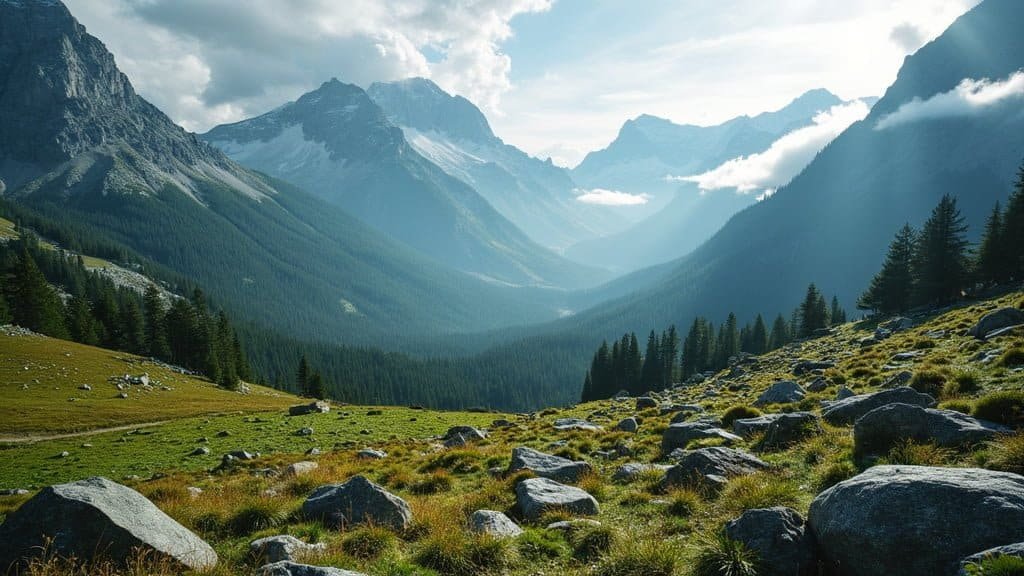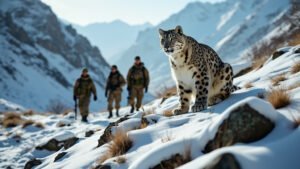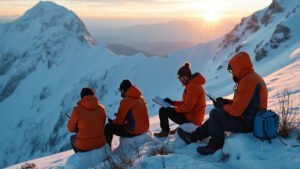Introduction
Snow leopards, known for their elusive nature and striking beauty, inhabit some of the most rugged terrains on Earth. Preserving their habitats is crucial for their survival, and protected areas play a significant role in this effort
This article delves into the various aspects of snow leopard conservation, starting with the primary threats these majestic animals face. It explores the benefits and challenges of protected areas, highlighting successful case studies and the importance of community involvement. By examining these elements, we gain a comprehensive understanding of how effective protected areas are in preserving snow leopard habitats
Main Threats to Snow Leopard Habitats
Snow leopards face a multitude of threats that jeopardize their habitats and survival. Understanding these threats is essential for implementing effective conservation strategies within protected areas
This section explores the primary dangers to snow leopard habitats, including habitat loss, poaching and illegal trade, and climate change
Habitat Loss
Habitat loss is a critical issue for snow leopards. Their natural environments are being increasingly encroached upon by human activities such as agriculture, mining, and infrastructure development
According to a study by the Snow Leopard Trust, approximately 40% of the snow leopard’s habitat is at risk due to these activities (McCarthy et al., 2016). This fragmentation of their living spaces not only reduces the area available for hunting and breeding but also isolates populations, making it difficult for them to interact and reproduce
Protected areas aim to mitigate habitat loss by designating specific regions where human activities are restricted or regulated
For instance, the establishment of large protected areas like the Qomolangma (Everest) National Nature Preserve in China has been crucial in safeguarding vast tracts of snow leopard habitat. However, enforcing these protections consistently remains a challenge, especially in regions where economic pressures drive illegal land use
Poaching and Illegal Trade
Poaching and the illegal trade of snow leopard parts pose significant threats to their survival. Snow leopards are hunted for their beautiful pelts and bones, which are highly valued in illegal wildlife markets
The Snow Leopard Trust reports that between 220 and 450 snow leopards are killed each year due to poaching (Snow Leopard Trust, 2017). This illegal activity not only directly reduces snow leopard numbers but also disrupts their social structures and breeding cycles
Protected areas can provide a refuge from poaching, where anti-poaching patrols and surveillance can be more effectively implemented. For example, in the Tost Tosonbumba Nature Reserve in Mongolia, concerted efforts by rangers and local communities have significantly reduced poaching incidents
Nevertheless, poaching continues outside these protected areas, highlighting the need for broader regional and international cooperation to combat wildlife crime
Climate Change
Climate change is an emerging threat that could profoundly impact snow leopard habitats. Rising temperatures and changing precipitation patterns are altering the ecosystems of the high mountain regions where snow leopards live
Research by Forrest et al. (2012) indicates that climate change could reduce suitable habitats for snow leopards by as much as 30% over the next century. Melting glaciers and shifting vegetation zones not only affect the availability of prey but also force snow leopards to move to higher, less hospitable altitudes
Protected areas must be adaptable to these changes, ensuring they encompass a range of altitudes and microhabitats to provide refuges under varying climate scenarios. Some regions, such as the Sanjiangyuan National Nature Reserve in China, have been proactive in expanding protected zones to include critical climate refuges
However, climate adaptation strategies must be integrated into all levels of conservation planning to effectively safeguard snow leopards against this global threat
Understanding the main threats to snow leopard habitats is the first step in developing effective conservation strategies. While protected areas offer significant benefits, they are not a panacea and must be part of a broader, multifaceted approach to snow leopard conservation
Efforts must include strong anti-poaching measures, habitat preservation, and climate adaptation strategies to ensure the survival of these magnificent animals
Benefits of Protected Areas for Snow Leopards
Protected areas serve as a crucial tool in the conservation of snow leopards by providing safe havens from various threats
This section explores the specific benefits that these designated regions offer to snow leopards, including protection from poaching, preservation of prey species, and the reduction of human-wildlife conflict
Safe Havens from Poaching
One of the primary benefits of protected areas is the creation of safe havens where snow leopards are less vulnerable to poaching. Anti-poaching measures, such as patrolling and surveillance, are more effectively enforced within these regions
For example, the Hemis National Park in India, a known habitat for snow leopards, has implemented stringent anti-poaching laws that have led to a significant decline in poaching activities (Jackson & Ahlborn, 1988). The presence of trained wildlife rangers and the use of technology like camera traps and drones help monitor and protect snow leopards from illegal hunting
Protected areas also often involve community participation in anti-poaching efforts. In Mongolia’s Tost Tosonbumba Nature Reserve, local herders are engaged in conservation activities, including monitoring and reporting poaching incidents
This community-based approach not only aids in the direct protection of snow leopards but also fosters a sense of stewardship among local populations, making conservation efforts more sustainable in the long run
Preservation of Prey Species
Snow leopards rely on a stable prey base for survival, primarily consisting of ungulates such as blue sheep and ibex. Protected areas help preserve these prey species by maintaining their natural habitats and preventing overhunting by humans
In the Altai-Sayan Ecoregion, which spans Russia, Mongolia, Kazakhstan, and China, protected areas have been established to conserve the habitat of these key prey species, ensuring that snow leopards have sufficient food resources (WWF, 2020)
By safeguarding both the snow leopards and their prey, protected areas help maintain the ecological balance necessary for the species’ survival
Effective management of these regions includes habitat restoration projects, anti-poaching patrols for prey species, and controlled grazing practices to prevent habitat degradation. These efforts contribute to a healthier ecosystem where snow leopards can thrive
Reduction of Human-Wildlife Conflict
Human-wildlife conflict is a significant issue in areas where snow leopards and humans share the same space. Snow leopards sometimes prey on livestock, leading to retaliatory killings by herders
Protected areas help mitigate this conflict by providing buffer zones where human activities are limited or managed. This spatial separation reduces the likelihood of encounters between snow leopards and livestock
Moreover, some protected areas implement compensation programs for livestock losses due to snow leopard predation. The Snow Leopard Conservancy’s community-based initiatives in Nepal and India provide financial compensation to herders who lose livestock, reducing the incentive for retaliatory killings (Oli, McNeely, & Taylor-Ide, 1994). These programs also promote livestock insurance schemes and improved herding practices to minimize losses
Additionally, education and awareness programs within protected areas help local communities understand the importance of snow leopards and the role they play in the ecosystem. These initiatives encourage coexistence and reduce antagonism towards these predators
The benefits of protected areas for snow leopards are manifold, from providing safe havens from poaching to preserving their prey species and reducing human-wildlife conflict. These designated regions are vital for the survival of snow leopards, ensuring that they have the necessary resources and protection to thrive
However, the success of protected areas depends on effective management, adequate funding, and the involvement of local communities in conservation efforts
Challenges in Managing Protected Areas
While protected areas offer numerous benefits for snow leopard conservation, they also face significant challenges. Effective management of these areas is crucial to ensuring they meet their conservation goals
This section examines the primary challenges, including insufficient funding, enforcement issues, and balancing human needs
Insufficient Funding
One of the most significant challenges in managing protected areas is securing sufficient funding. Establishing and maintaining these areas requires substantial financial resources for activities such as patrolling, habitat restoration, community outreach, and scientific research
According to a report by the Global Environment Facility, many protected areas globally suffer from chronic underfunding, which hampers their effectiveness (GEF, 2018)
In regions where economic resources are limited, protected areas often rely on international funding and grants. However, this funding can be unpredictable and insufficient to cover all necessary expenses
For example, the Qomolangma National Nature Preserve in China, despite its importance, struggles with budget constraints that affect its ability to effectively monitor and protect snow leopards (Li et al., 2017)
To address funding issues, innovative financing mechanisms are being explored. These include eco-tourism initiatives, payment for ecosystem services (PES), and public-private partnerships. In some areas, revenue generated from eco-tourism is reinvested into conservation activities, providing a sustainable funding source while promoting environmental awareness among tourists
Enforcement Issues
Enforcement of regulations within protected areas is another major challenge. Despite legal protections, illegal activities such as poaching, logging, and mining can still occur. Effective enforcement requires well-trained and adequately equipped personnel, as well as cooperation from local communities and authorities
In many protected areas, the lack of personnel and resources limits the ability to patrol vast and often remote regions
For instance, in the Tost Tosonbumba Nature Reserve in Mongolia, rangers face difficulties covering the entire reserve due to its large size and rugged terrain (Snow Leopard Trust, 2017). Furthermore, corruption and lack of political will can undermine enforcement efforts, allowing illegal activities to continue unchecked
Technological advancements, such as satellite monitoring, drones, and camera traps, are increasingly being used to enhance enforcement. These tools provide real-time data and help rangers monitor large areas more effectively. However, the high cost and technical expertise required to operate these technologies can be a barrier for some protected areas
Balancing Human Needs
Balancing the needs of local human populations with conservation goals is a complex challenge. Many protected areas overlap with regions where people live and depend on natural resources for their livelihoods. Restricting access to these resources can lead to conflicts and resistance from local communities
Engaging local communities in conservation efforts is crucial for the success of protected areas. Community-based conservation approaches, where locals are involved in decision-making and benefit-sharing, can help align conservation goals with community interests
For example, in Nepal’s Annapurna Conservation Area, community management has led to positive outcomes for both conservation and local livelihoods (Baral, Stern, & Heinen, 2007)
Education and awareness programs also play a vital role in fostering community support for conservation. By highlighting the ecological and economic benefits of protected areas, these programs can build a sense of ownership and responsibility among local populations
Furthermore, integrated land-use planning that considers both conservation and development needs is essential. This approach ensures that protected areas are managed in a way that supports sustainable development and minimizes negative impacts on local communities
Managing protected areas for snow leopard conservation involves navigating numerous challenges, from securing adequate funding to enforcing regulations and balancing human needs
Addressing these challenges requires a multifaceted approach that includes innovative financing, technological advancements, community engagement, and integrated planning. By overcoming these obstacles, protected areas can more effectively fulfill their role in preserving snow leopard habitats and ensuring the survival of this iconic species
Case Studies of Successful Conservation Efforts
Examining specific case studies of successful conservation efforts can provide valuable insights into the effectiveness of protected areas in preserving snow leopard habitats. This section highlights notable examples from India, Mongolia, and China
India’s Snow Leopard Project
India’s Snow Leopard Project, initiated in 2009, aims to safeguard snow leopards and their habitats through a comprehensive approach involving scientific research, community participation, and policy support. The project operates in the high-altitude regions of Jammu and Kashmir, Himachal Pradesh, Uttarakhand, Sikkim, and Arunachal Pradesh
One of the key successes of the Snow Leopard Project is its emphasis on community involvement. By engaging local communities in conservation activities, the project has fostered a sense of stewardship among residents. Community-based tourism initiatives, such as homestays and wildlife tours, provide economic benefits to locals while promoting snow leopard conservation
Additionally, the project has implemented measures to mitigate human-wildlife conflict. Livestock insurance schemes and predator-proof corrals help reduce retaliatory killings of snow leopards
The integration of modern technology, such as camera traps and satellite telemetry, has also enhanced monitoring and research efforts, providing valuable data on snow leopard populations and their movements (Sharma et al., 2014)
Mongolia’s Tost Tosonbumba Nature Reserve
The Tost Tosonbumba Nature Reserve in Mongolia, established in 2016, is a significant achievement in snow leopard conservation. This 1.8 million-acre reserve in the South Gobi region was created following years of advocacy by the Snow Leopard Trust and local communities
One of the notable successes of the Tost Tosonbumba Nature Reserve is its strong community involvement. Local herders, who once viewed snow leopards as threats to their livestock, now play a crucial role in monitoring and protecting these cats. The Snow Leopard Trust’s community-based conservation programs have helped build trust and collaboration between conservationists and local residents
The reserve has also benefited from innovative conservation strategies, such as the use of GPS collars to track snow leopard movements. This data helps researchers understand the cats’ habitat use and develop targeted conservation measures. Furthermore, the establishment of the reserve has led to a significant reduction in mining activities, which posed a major threat to the snow leopard habitat (Snow Leopard Trust, 2017)
China’s Sanjiangyuan National Nature Reserve
China’s Sanjiangyuan National Nature Reserve, located in the Tibetan Plateau, is one of the largest protected areas for snow leopards, spanning over 123,000 square miles
Established in 2000, the reserve aims to conserve the headwaters of the Yangtze, Yellow, and Mekong rivers, as well as the diverse wildlife that inhabits the region, including snow leopards
One of the key successes of the Sanjiangyuan National Nature Reserve is its integrated approach to conservation and sustainable development. The reserve combines habitat protection with efforts to improve the livelihoods of local communities. Eco-compensation schemes provide financial incentives to herders who reduce their grazing pressure on the land, thereby aiding habitat restoration
The reserve has also implemented various scientific research and monitoring programs. The use of camera traps and genetic sampling has provided critical insights into snow leopard populations and their prey
Additionally, the reserve’s conservation efforts have been supported by international partnerships and funding, enhancing its capacity to protect snow leopards and their habitats (Li et al., 2018)
These case studies demonstrate that with the right combination of community involvement, innovative conservation strategies, and adequate funding, protected areas can be highly effective in preserving snow leopard habitats. Each of these examples highlights different approaches to overcoming the challenges of conservation and offers valuable lessons for future efforts
Community Involvement in Conservation
Community involvement is a critical component of successful snow leopard conservation efforts. Engaging local populations not only enhances the effectiveness of protected areas but also fosters sustainable practices and mutual benefits
This section explores various aspects of community involvement, including local partnerships, eco-tourism initiatives, and education and awareness programs
Local Partnerships
Forming partnerships with local communities is essential for the success of conservation projects
Local residents often have extensive knowledge of the landscape and wildlife, making them invaluable allies in monitoring and protecting snow leopards. Collaborative efforts ensure that conservation measures are culturally appropriate and more likely to be supported by the community
One successful example is the Snow Leopard Enterprises program initiated by the Snow Leopard Trust. This program provides economic incentives to herders in Mongolia, Kyrgyzstan, and India, in exchange for their commitment to protect snow leopards
By producing and selling handicrafts, participating families gain a sustainable income, reducing their reliance on livestock and decreasing the likelihood of human-wildlife conflict (Snow Leopard Trust, 2017)
Eco-tourism Initiatives
Eco-tourism has emerged as a powerful tool for snow leopard conservation. Properly managed, eco-tourism can provide financial benefits to local communities while promoting the protection of snow leopard habitats. Tourists are willing to pay for the unique experience of spotting a snow leopard in the wild, and this revenue can be reinvested into conservation efforts
For instance, in the Hemis National Park in India, eco-tourism has been integrated into the park’s management plan
Local guides, trained by conservation organizations, lead wildlife tours, creating job opportunities and raising awareness about the importance of protecting snow leopards. The income generated supports conservation activities such as anti-poaching patrols and habitat restoration projects
Eco-tourism also encourages community members to value wildlife as a sustainable resource. When locals benefit financially from the presence of snow leopards, they are more likely to support and engage in conservation efforts. However, it is crucial to manage eco-tourism carefully to ensure that it does not negatively impact the animals or their habitat
Education and Awareness Programs
Education and awareness programs are vital for fostering a conservation ethic within local communities. These programs help people understand the ecological importance of snow leopards and the benefits of conserving their habitats. By raising awareness, conservation organizations can reduce human-wildlife conflicts and promote coexistence
In Nepal, the Snow Leopard Conservancy has implemented education programs targeting schoolchildren, herders, and community leaders
These programs include workshops, wildlife clubs, and educational materials that highlight the significance of snow leopards and the need for their protection. Engaging children in conservation activities helps instill a sense of responsibility and passion for wildlife from an early age (Ale, Yonzon, & Thapa, 2007)
Additionally, involving community members in scientific research and monitoring can be an effective educational tool
Citizen science initiatives, where locals collect data on snow leopard sightings and tracks, not only contribute valuable information but also deepen participants’ understanding and appreciation of wildlife conservation
Community involvement in conservation is essential for the long-term success of protected areas and snow leopard protection. By forming local partnerships, promoting eco-tourism, and implementing education and awareness programs, conservationists can build strong support networks that enhance the sustainability and effectiveness of their efforts
These collaborative approaches ensure that conservation measures are not only scientifically sound but also socially and economically beneficial
Conclusion
Protected areas play a vital role in the conservation of snow leopards by providing safe habitats, reducing human-wildlife conflicts, and preserving prey species
However, the success of these areas depends on effective management, adequate funding, community involvement, and overcoming challenges such as enforcement and balancing human needs. The case studies from India, Mongolia, and China highlight the potential of protected areas to significantly contribute to snow leopard conservation
By addressing the challenges and leveraging community partnerships, eco-tourism, and education, protected areas can become even more effective in ensuring the survival of these magnificent creatures











